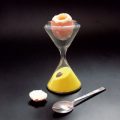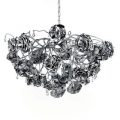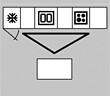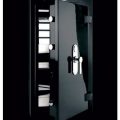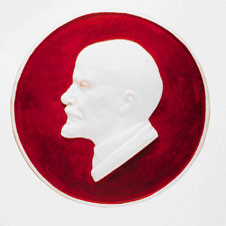 Porcelain products
Porcelain products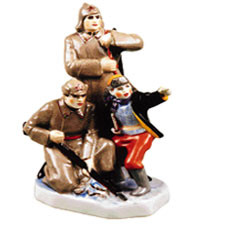 Agitfarfor
Agitfarfor In the first months after the revolutionA new team of artists headed by Sergei Chekhnin came to the State Porcelain Factory in Petrograd (hastily renamed from the Imperial; in 2005 this name was returned to it). In 1918, the Chekhninites received their first order from the Bolshevik government - to make "busts of revolutionary figures and utilitarian-decorative objects with revolutionary slogans". According to Lenin's propaganda plan, symbols of the new power were to be placed everywhere. Even matchboxes and plates were to tell the victorious proletariat about the accomplishments of the revolution. The authorities did not yet specify what and in what style to paint, so the factory's artists often decorated items of propaganda porcelain with paintings in the style of Cubo-Futurism* or Suprematism. However, propaganda porcelain was never available to those to whom it was addressed directly. It was too expensive for a simple worker or peasant, and from the factory workshops it was sent to European exhibitions and auctions, to private collections. Since 1921, all Lfz products were exported exclusively. The reorientation to the West quickly became noticeable to the naked eye - inscriptions in English and German appeared on the dishes, and revolutionary themes were increasingly replaced by illustrations to Russian fairy tales. In the late 1960s, Lfz began reissuing the most famous examples of propaganda and Suprematist porcelain based on sketches by Chekhonin and Suetin. What does porcelain call for? The slogans with which the artists decorated the a and teapots were personally approved by Comrade Lenin. Among the things he approved were statements by Tolstoy, Dostoevsky and Karl Marx, as well as quotations from the anarchist Bakunin, the philosopher Confucius, the poet Ovid, the orator Cicero, the utopian Thomas More, the art theorist John Ruskin and, oddly enough, from the Gospel! In the 1930s, more laconic and accessible words appeared on mass-produced tableware: "Give us Turksib!", "Oil for the country!", "Listen to the radio!" and even "Brush your teeth!" However, even at that time many critics spoke out against decorating tableware with slogans. Cups should not call for something or demand something; let them please the eye with floral patterns instead." these politically illiterate individuals insisted.
In the first months after the revolutionA new team of artists headed by Sergei Chekhnin came to the State Porcelain Factory in Petrograd (hastily renamed from the Imperial; in 2005 this name was returned to it). In 1918, the Chekhninites received their first order from the Bolshevik government - to make "busts of revolutionary figures and utilitarian-decorative objects with revolutionary slogans". According to Lenin's propaganda plan, symbols of the new power were to be placed everywhere. Even matchboxes and plates were to tell the victorious proletariat about the accomplishments of the revolution. The authorities did not yet specify what and in what style to paint, so the factory's artists often decorated items of propaganda porcelain with paintings in the style of Cubo-Futurism* or Suprematism. However, propaganda porcelain was never available to those to whom it was addressed directly. It was too expensive for a simple worker or peasant, and from the factory workshops it was sent to European exhibitions and auctions, to private collections. Since 1921, all Lfz products were exported exclusively. The reorientation to the West quickly became noticeable to the naked eye - inscriptions in English and German appeared on the dishes, and revolutionary themes were increasingly replaced by illustrations to Russian fairy tales. In the late 1960s, Lfz began reissuing the most famous examples of propaganda and Suprematist porcelain based on sketches by Chekhonin and Suetin. What does porcelain call for? The slogans with which the artists decorated the a and teapots were personally approved by Comrade Lenin. Among the things he approved were statements by Tolstoy, Dostoevsky and Karl Marx, as well as quotations from the anarchist Bakunin, the philosopher Confucius, the poet Ovid, the orator Cicero, the utopian Thomas More, the art theorist John Ruskin and, oddly enough, from the Gospel! In the 1930s, more laconic and accessible words appeared on mass-produced tableware: "Give us Turksib!", "Oil for the country!", "Listen to the radio!" and even "Brush your teeth!" However, even at that time many critics spoke out against decorating tableware with slogans. Cups should not call for something or demand something; let them please the eye with floral patterns instead." these politically illiterate individuals insisted.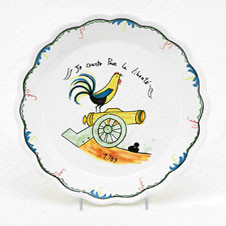
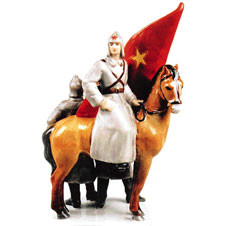
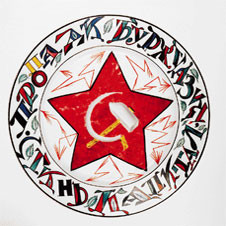 Porcelain, but not the same Already in the early 1920sThe excitement among Western collectors led to the fact that Soviet porcelain began to be actively counterfeited in Germany. The "passport" of porcelain tableware is the marks on the bottom of the item. The early and most valuable examples of agitational porcelain were made on the basis of pre-revolutionary "linen" items that had not yet been painted. On their bottom were preserved marks from the tsarist era (the letters "Н-II", "А-II", "А-III" under the imperial crown) or the sign of the Provisional Government - a double-headed eagle in a circle with the date "1917". During the production of agitational porcelain, these symbols were painted over with a green rhombus or oval, and a new mark was placed next to it - "Н-II", "А-II", "А-III ... crossed sickle, hammer and part of a gear. Counterfeiters usually just draw green diamonds or ovals in this place.
Porcelain, but not the same Already in the early 1920sThe excitement among Western collectors led to the fact that Soviet porcelain began to be actively counterfeited in Germany. The "passport" of porcelain tableware is the marks on the bottom of the item. The early and most valuable examples of agitational porcelain were made on the basis of pre-revolutionary "linen" items that had not yet been painted. On their bottom were preserved marks from the tsarist era (the letters "Н-II", "А-II", "А-III" under the imperial crown) or the sign of the Provisional Government - a double-headed eagle in a circle with the date "1917". During the production of agitational porcelain, these symbols were painted over with a green rhombus or oval, and a new mark was placed next to it - "Н-II", "А-II", "А-III ... crossed sickle, hammer and part of a gear. Counterfeiters usually just draw green diamonds or ovals in this place.

Making Money with Desserts: Success Stories
Evgeniya Polischuk (Fedutinova) instagram:@evgeniyafedutinovavk.com/janeshomebaking– It all started with baking for family and friends. Gradually, I started posting photos of my baked goods on Instagram – and orders started coming in. I made my first custom-made cake on October 13, 2014, and a little earlier I started making macaroons and cupcakes. You could say that the business “found me”, I am very […]

Soups are cold recipes with photos
Cold cucumber soup with yogurt and lemonsorbet from the chef of the restaurant La Taverna Alexander Zhurkin Photo: Getty Images Ingredients: Plain yoghurt – 125 g Cucumber – 150 g Lemon/lime sorbet – 50 g Cocktail shrimp – 24 g Fresh ginger juice – 1 g Lime juice – 5 g Fresh orange juice – 5 g Parsley – 1 g Pink pepper – 1 g Watercress – […]

barbeque kebab
Pork tenderloin in glaze Photo:Dmitry Bayrak/dbstudioPreparation time: 20 minutes + marinating time.Calories: 454 kcal per serving.For 4 servings: 4 pork tenderloins (approximately 300 g each), 1 onion, 2 cloves of garlic, 1 tsp. lemon zest, 1 tsp. lemon juice, a pinch of ground cumin, coriander and turmeric, 1 tbsp. vegetable […]

Pierre Duacan: dietary recipes: Ducane diet
Beetroot soup Photo:Season’S, Luxury Hotels RepresentationYou will need:· Boiled beetroot – 60 g· Fresh cucumbers – 20 g· Red radish – 20 g· Green onions – 10 g· Egg – 1 pc.· Drinking mineral water – 200 g· Salt – 1 gPreparation:· Boil the egg and beetroot.· Grate the cucumbers, radish and part of the beetroot. Put everything […]
